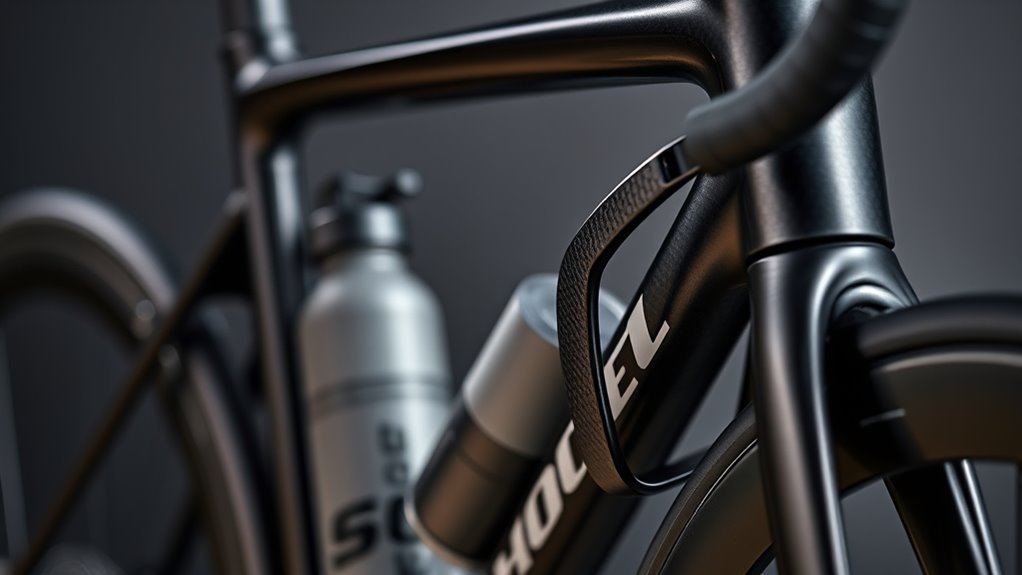Aerodynamic bottle cages are designed to reduce drag and boost speed by streamlining airflow around your hydration setup. However, most benefits are subtle and often fall short of marketing claims, especially for casual riders. While they might offer slight improvements at elite racing levels, they usually aren’t worth the high cost for everyday use. If you want to explore whether these cages are worth it for your cycling goals, there’s more to consider below.
Key Takeaways
- Aerodynamic cages can slightly reduce drag, offering marginal speed benefits mainly noticeable at high racing speeds.
- The performance gains are often minimal and may not justify higher costs for casual riders.
- Proper installation and design influence actual aerodynamic benefits, but small improvements are common.
- Industry experts and athletes acknowledge marginal gains, yet emphasize technique and light components often yield better results.
- Visual appeal and brand reputation may influence purchasing decisions more than the actual aerodynamic performance.
What Are Aerodynamic Bottle Cages and How Do They Work?
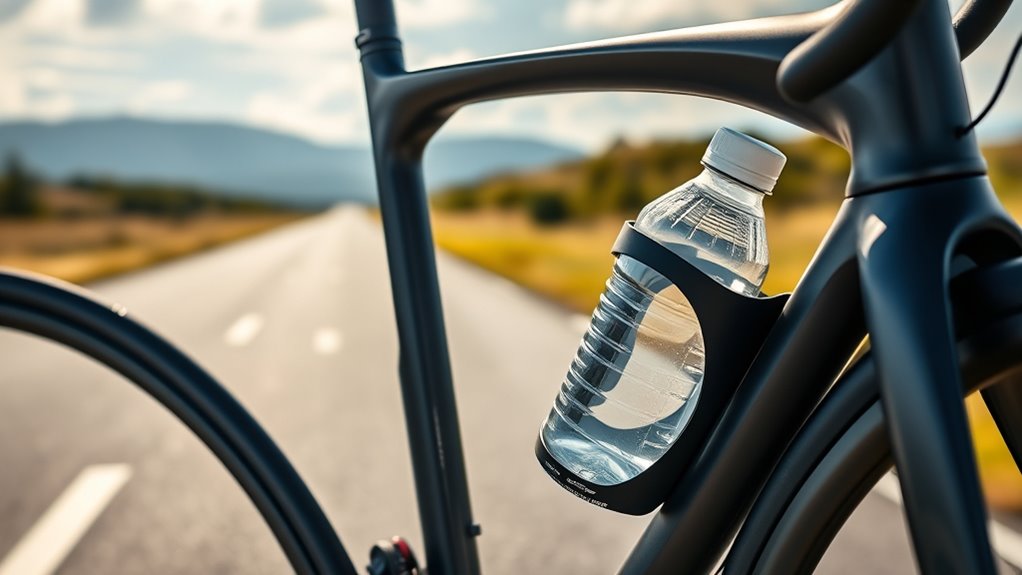
Aerodynamic bottle cages are specially designed cycling accessories that minimize air resistance while holding water bottles. They improve water bottle aerodynamics by shaping the cage to reduce drag, allowing you to maintain higher speeds with less effort. These cages often have sleek, tight-fitting designs that streamline airflow around your bike and hydration setup. By integrating aerodynamic principles, they help optimize cycling hydration strategies without adding significant weight or bulk. When riding in fast-paced races or time trials, every marginal gain counts, and reducing drag from your water bottle can make a noticeable difference. Proper placement and choosing the right cage can enhance your bike’s overall efficiency, making hydration easier and less disruptive to your aerodynamic profile.
The Science Behind Aerodynamics and Drag Reduction
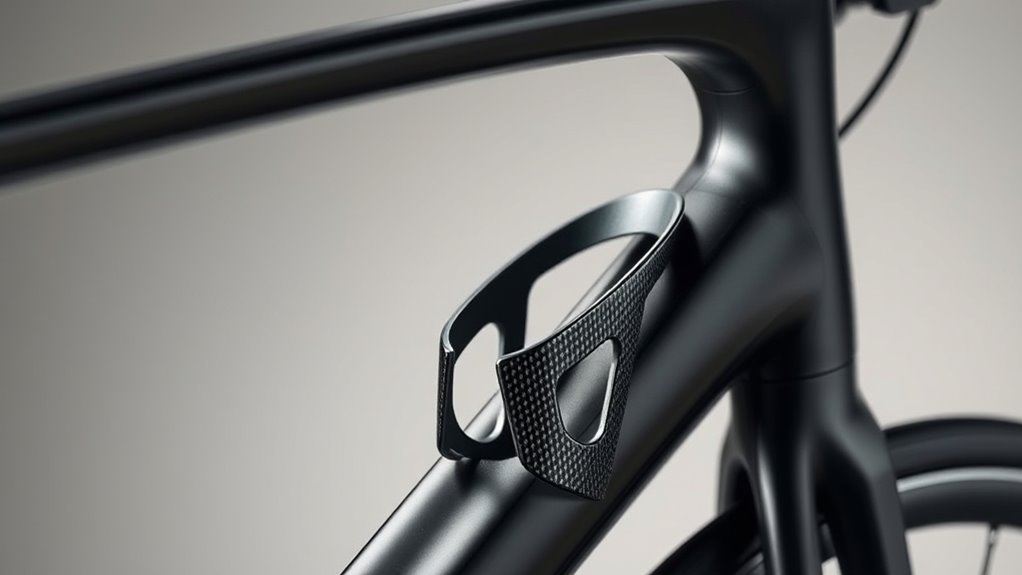
Understanding how shapes and airflow interact is key to grasping how aerodynamic bottle cages reduce drag. When air flows smoothly around the bike, less resistance means higher efficiency. Wind tunnel testing reveals how different cage designs influence airflow dynamics, showing where turbulence creates drag. By optimizing the shape, designers minimize airflow separation and vortices that slow you down.
- How streamlined shapes guide airflow smoothly
- The role of surface finish in reducing drag
- Impact of airflow separation points
- Differences between traditional and aerodynamic cages
- How turbulence increases resistance and how to prevent it
These insights help explain why even small changes in design can make a difference. The science behind aerodynamics isn’t just theory—it’s applied in real-world testing to improve cycling performance.
Evaluating Performance: Do They Make a Difference in Real-World Cycling?
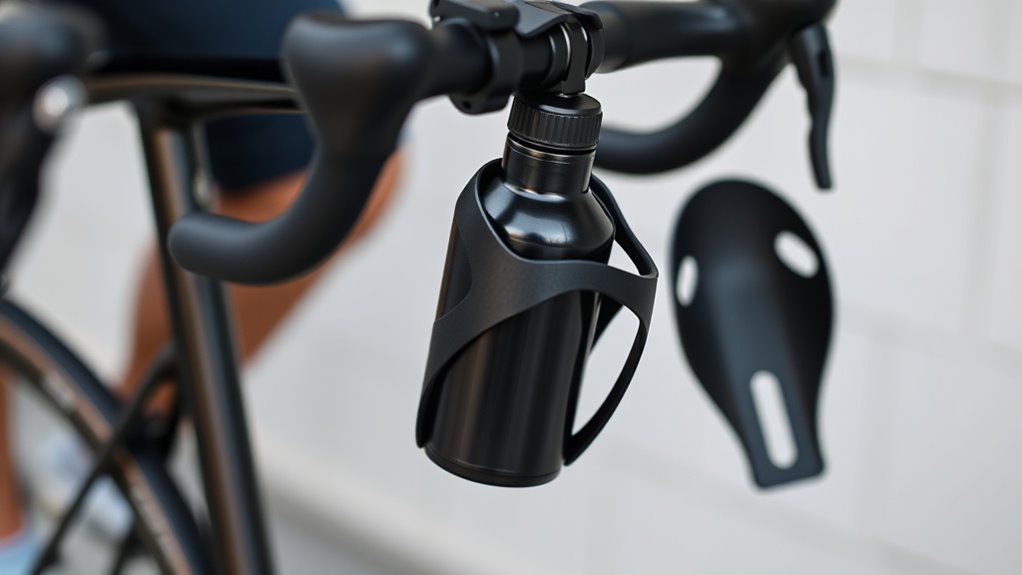
You might wonder if aerodynamic bottle cages truly boost your speed on the road. Their streamlined design reduces drag, but the real-world impact can vary depending on conditions and rider effort. Additionally, high-performance materials used in some cages can contribute to marginal gains by further minimizing weight and turbulence. A performance-focused approach in cycling accessories emphasizes that subtle enhancements can lead to noticeable improvements over time, much like the potential benefits of aerodynamic design. Glycolic acid benefits in skincare show that subtle enhancements can lead to noticeable improvements over time, much like the potential benefits of aerodynamic design. Moreover, ongoing AI safety measures in the development of cycling technology aim to ensure that innovations like aerodynamic cages are both effective and safe. Infidelity cases often lead to significant emotional and financial consequences, highlighting that even small advantages can have large repercussions. Let’s explore whether these cages deliver noticeable performance benefits during actual cycling.
Streamlined Aerodynamics Benefits
While the theoretical benefits of streamlined bottle cages suggest they can reduce drag, evaluating their real-world impact requires more than just numbers. You might notice subtle gains that affect your cycling aesthetics and overall experience. These cages often appeal to brand marketing, emphasizing sleek designs that blend form and function. While aerodynamic improvements can contribute to faster rides, their actual effect depends on factors like riding conditions and rider effort. To deepen your understanding, consider:
- How much drag reduction truly influences speed
- The role of visual appeal in cycling aesthetics
- The perception of performance benefits versus marketing hype
- The importance of integrated design for overall aerodynamics
- The psychological boost from owning high-tech gear
Additionally, understanding the specific aerodynamic benefits of different cage designs can help determine whether investing in these accessories is worthwhile. As material technology continues to evolve, future advancements in textile line innovations may lead to even more efficient aerodynamic solutions. Ultimately, the real-world benefits are often marginal but can enhance the rider’s confidence and style.
Practical Impact on Speed
Although aerodynamic bottle cages are designed to reduce drag, their actual impact on cycling speed is often minimal in real-world conditions. While they improve aerodynamic efficiency slightly, the overall time savings are usually negligible unless you’re racing at the highest levels. The weight savings from these cages are minimal and rarely affect your performance unless every gram counts, such as in time trials. Factors like rider power, terrain, and wind have a more significant influence on your speed than minor aerodynamic tweaks. For most cyclists, investing in lightweight components or improving riding technique yields better results than focusing solely on aerodynamic bottle cages. Proper installation and positioning are essential to maximize any potential benefits. Ultimately, these cages offer marginal benefits that are unlikely to make a noticeable difference during typical rides.
Cost vs. Benefit: Are They a Worthwhile Investment?

You need to contemplate whether the performance gains of aerodynamic bottle cages justify their higher cost. While they may improve your bike’s efficiency, the practical benefits might not outweigh the expense for every rider. Let’s analyze the price versus performance to see if they’re truly a worthwhile investment. For some cyclists, the marginal gains are comparable to the growing popularity of Halloween in certain regions, where increased interest does not always translate into significant cultural change or practical value. Considering the aesthetic appeal of vintage decor, some riders may prefer the classic look of traditional cages despite the marginal aerodynamic benefits. Additionally, understanding the cookie categories can help you manage your online preferences and privacy while researching these options. Being aware of legal and financial matters related to product investments ensures you make informed choices that align with your overall budget and goals.
Price vs. Performance
Investing in aerodynamic bottle cages often sparks the question of whether their performance benefits justify the higher price tags. You need to contemplate if the weight savings and sleek aesthetic appeal genuinely enhance your ride. While these cages can reduce drag slightly, the cost may outweigh the benefits for casual riders. Considering the science behind aerodynamics can help determine if the marginal gains are meaningful for your cycling efficiency. Additionally, understanding asset division principles, such as cost-effective strategies, can provide perspective on evaluating whether the investment aligns with your overall cycling budget and goals.
Consider these points:
- Marginal aerodynamic improvements may not noticeably impact your speed
- Higher prices often mean premium materials and aesthetics
- Weight savings can be minimal but add up over long rides
- The visual appeal might boost your bike’s look but doesn’t improve function
- Cost differences can be significant compared to standard cages
Ultimately, you must decide if the performance gains are worth the investment for your cycling goals.
Practical Benefits Analysis
While aerodynamic bottle cages may offer slight reductions in drag, their practical benefits often depend on your riding style and goals. If you’re a competitive cyclist seeking every marginal gain, investing in these cages might be worthwhile, especially if the aesthetic appeal enhances your bike’s sleek look. They can boost confidence during races and make your bike stand out, influenced by brand reputation and design. However, if you’re a casual rider focused on comfort or convenience, the cost may outweigh the benefits. Remember, the brand influence can sway purchasing decisions, but evaluate whether the performance boost justifies the investment. Ultimately, consider your priorities: if marginal aerodynamic gains align with your goals, aerodynamic cages could be a worthwhile addition; if not, they remain a marketing gimmick. Additionally, understanding the divorce process and requirements can help you make informed decisions about your investments and commitments.
Opinions From Experts and Athletes
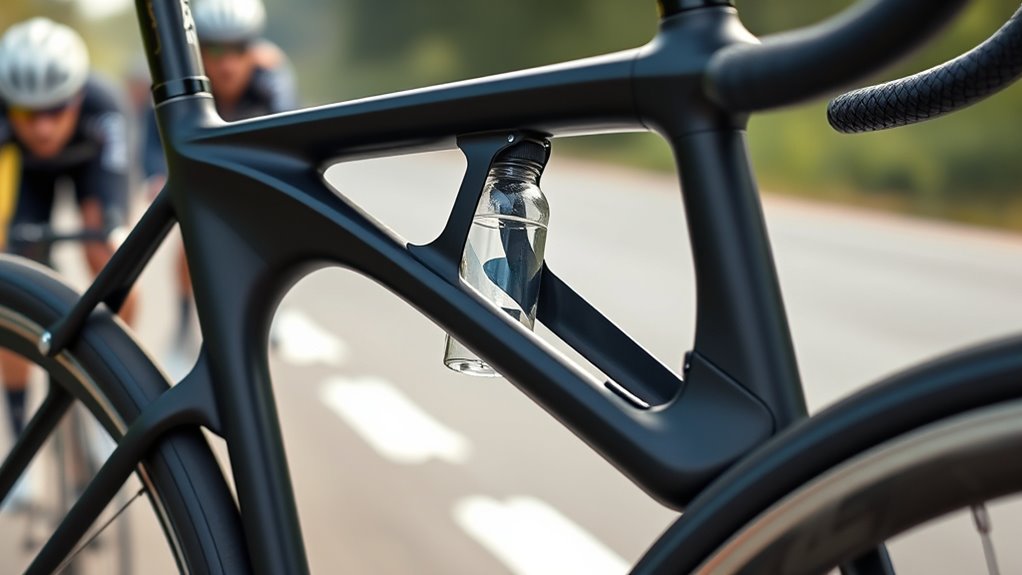
Experts and athletes often emphasize the importance of aerodynamic bottle cages in minimizing drag and boosting performance. They believe that even small improvements can make a difference during races. Many appreciate the sleek aesthetic appeal these cages add to bikes, making them look modern and professional. Additionally, brand reputation plays a role; trusted brands often assure quality and durability, giving riders confidence. Here are some insights from industry insiders:
Aerodynamic cages boost performance, enhance bike aesthetics, and build rider confidence through trusted brands.
- Athletes report noticeable gains in race times with high-quality cages
- Coaches highlight aerodynamic cages as part of a thorough performance strategy
- Experts cite aesthetic appeal as motivating for riders who value style
- Brand reputation influences purchase decisions more than marginal gains alone
- Some pros see aerodynamic cages as a way to showcase innovation and professionalism
These opinions shape how riders view the true value of aerodynamic bottle cages.
Making an Informed Choice: Are They Right for You?

Are aerodynamic bottle cages worth considering for your cycling needs? It’s important to cut through the marketing hype and assess if they genuinely benefit you. If you’re chasing every marginal gain, these cages might seem appealing, but they often offer minimal performance improvements. Consider whether the aesthetic appeal aligns with your bike’s look and your personal style. If style and sleekness motivate you more than measurable speed gains, then they could be a good fit. However, if practicality, ease of use, or durability matter more, standard cages might be better. Making an informed choice means weighing the minor aerodynamic benefits against your priorities. Ultimately, it’s about deciding whether these cages serve your riding goals or if they’re just marketing gimmicks designed to appeal to your desire for a sleek bike.
Frequently Asked Questions
How Much Weight Do Aerodynamic Bottle Cages Typically Add to a Bike?
You might wonder how much weight aerodynamic bottle cages add, and it varies with material differences. Generally, they add only a few grams—around 10 to 20 grams—compared to standard cages. Lightweight options made from carbon fiber or titanium help minimize weight savings, so you won’t notice a big difference on the scale. While they offer aerodynamic benefits, their impact on overall weight is minor, making them more about marginal gains than a significant change.
Are There Specific Bike Frames or Setups That Benefit More From These Cages?
Imagine shaving just 1 second off a 40-minute ride—that’s the kind of impact aerodynamic bottle cages aim for. You’ll find they benefit frames with tight clearance where traditional cages don’t fit well, especially aero or time-trial bikes. Your rider preferences, like prioritizing speed over weight, also matter. Check frame compatibility first; if your setup’s streamlined, these cages can provide a tangible, race-winning edge.
Can Aerodynamic Bottle Cages Be Used With Standard Water Bottles?
You can definitely use aerodynamic bottle cages with standard water bottles. They’re designed for material compatibility, so most bottles fit well and stay secure during rides. Plus, they often enhance aesthetic appeal, giving your bike a sleek, streamlined look. Just make certain the cage matches your bottle’s size and material, and you’ll enjoy the benefits without sacrificing practicality or style. These cages combine function and form effectively for everyday cycling.
Do They Require Special Maintenance or Cleaning Techniques?
You don’t need special cleaning protocols for aerodynamic bottle cages; regular cleaning with mild soap and water suffices. Maintenance frequency depends on your riding habits—clean more often if you ride in muddy or dusty conditions. Check for debris or damage periodically to guarantee peak performance. By maintaining these cages properly, you’ll keep your bottles secure and avoid any potential issues during rides, maximizing their aerodynamic benefits.
How Do Aerodynamics Impact Overall Cycling Performance Beyond Bottle Cages?
Imagine opening hidden potential—your frame aerodynamics and rider positioning are game-changers. They reduce drag, boost speed, and conserve energy over long distances. Subtle tweaks to your posture or frame shape can make a dramatic difference, pushing you ahead of the pack. When you optimize these elements, you’re not just riding; you’re slicing through air with precision, turning every effort into maximum performance. The impact is truly astonishing.
Conclusion
Ultimately, deciding on aerodynamic bottle cages depends on your dedication and desire for discreet gains. If you’re chasing marginal improvements and maximizing every ounce of efficiency, they might be worth considering. But if you’re after immediate impact or tight budgets, they could be more marketing than measurable. Weigh the worth, wonder if the want outweighs the worry, and walk your way into a wise, well-informed choice. Your ride, your rules—make it matter.
